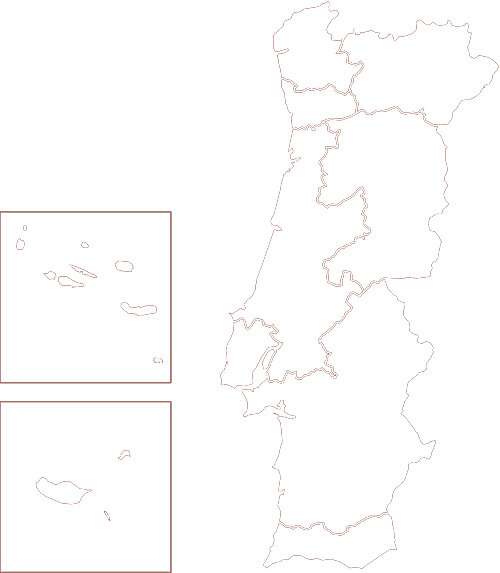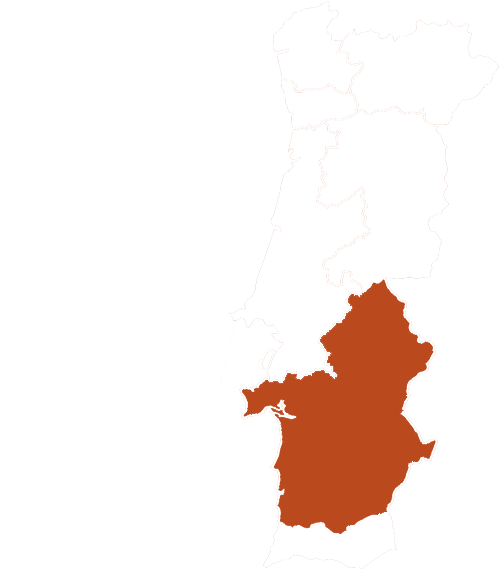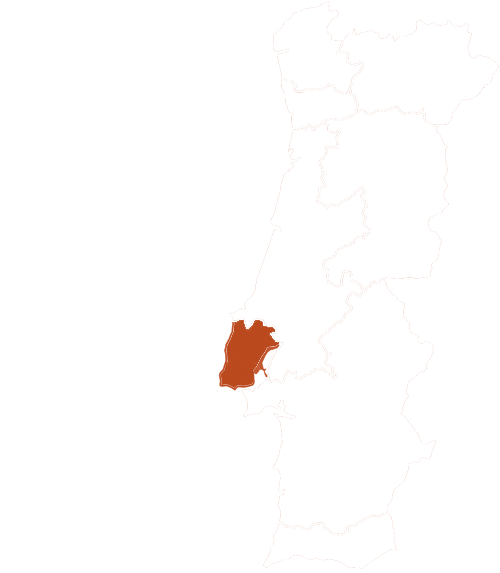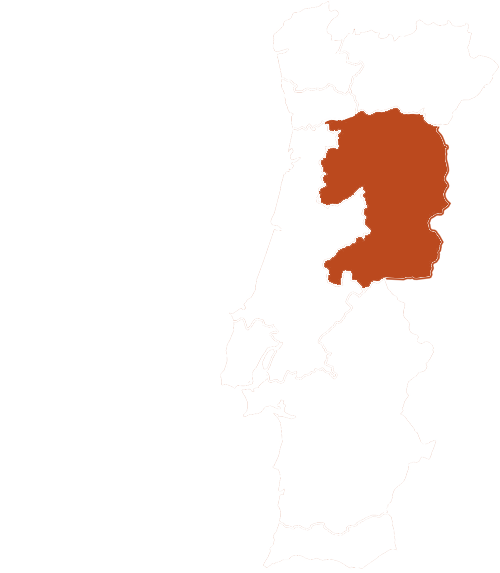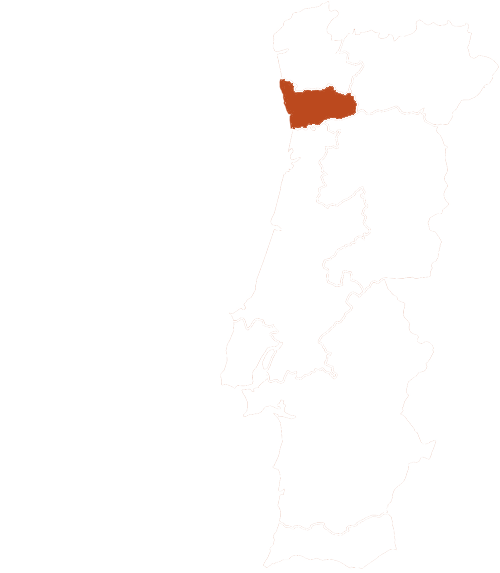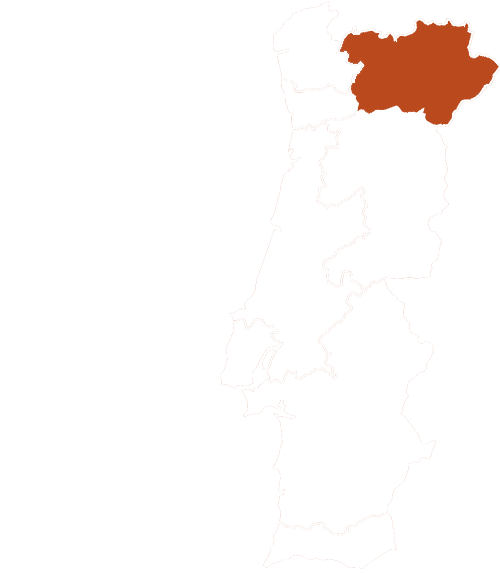Delight yourself in a country where everything is still authentic – the people, the nature, the gastronomy and the small pleasures of daily life. Discover the contrasts and commonalities between sea, rivers, cities, mountains and plains. Taste the best Portuguese flavors and rest in hotels of exquisite charm.
Full-day private guided tour in Lisbon
Upon arrival at Lisbon airport, reception by TravelTailors guide and delivery of all the documents you will need for your trip in Portugal!
Today you will have a full-day guided tour in Lisbon. You will enjoy every moment, drink in all the important historical aspects and have a delicious lunch with the best fresh ingredients!
Lisbon is one of the most fascinating cities in Europe! With blue skies almost, all year round and a mild winter, Lisbon offers breathtaking panoramas of the city and the river, a picturesque setting, where old trams take us from the narrow-cobbled streets up to the excellent new hotels in broad boulevards, with fabulous shopping opportunities of famous stylists and brands and a fantastic nightlife. The antique blends with the sophistication of the 21st century. Alfama and the Castle invite you to a historic trip to the Arab and medieval times. In the areas of Chiado, Bairro Alto and Príncipe Real, you can find some of the trendiest restaurants and bars in Lisbon. During the day, the streets are filled with animated crowds strolling around the museums, the shops, the art galleries, the cafes or grocery stores that sell gourmet products. From the Baixa to the Marquês de Pombal Square, there are theaters, train stations, cafes and alleys to take a walk in.
In Belém you will find the majestic Mosteiro dos Jerónimos (Jerónimos Monastery), the famous Torre de Belém (Tower of Belém), the Centro Cultural de Belém (Cultural Centre of Belém) and the many museums and gardens that surround them. It is imperative to taste the delicious Pastéis de Belém!
After this first day in Lisbon your private driver will take to your hotel.
Accommodation in one of our suggested Luxury, Premium or Boutique Hotels
Free day to enjoy the city at your own pace
We suggest a very typical Hills Trams Tour. It will take you through some of the most interesting streets with an audio-guide to add some extra information to your tour. Wind your way through the hills of Lisbon and discover its most historic quarters, where people chat from their window ledges and clothes hang out to dry in the sun. The contrasts in this richly diverse city will amaze you. From the simplicity of the traditional quarters of Alfama, Castelo and Bairro Alto, to the sophistication of Lapa.
This is a real ex-libris of Lisbon, and one of the best ways to see the city. From the windows of this picturesque means of transportation you can appreciate all the historical and natural heritage that Lisbon has to offer, from the imposing Basilica da Estrela to the monumental Castelo de São Jorge, in the medieval area of the capital. The "Yellow" tram as it is affectionately dubbed by the inhabitants of Lisbon, is part of a set of vehicles originally imported from the United States in 1901 with the aim of replacing the old horse-drawn carriages, which were the main means of transportation at that time.
Accommodation in one of our suggested Luxury, Premium or Boutique Hotels
Full-day private guided tour in Sintra and Cascais
Today after breakfast, your guide will pick you at the hotel for a full day trip through Cascais and Sintra. Sintra is a romantic region, with many charms, and is the homeland of the delicious sweet queijadas (made with cheese or curd cheese, eggs, milk and sugar) and travesseiros de Sintra (a cake filled with sweet egg yolk and an almond touch). Monuments, sea and mountains get together in one of the most perfect combinations. The Serra de Sintra (Sintra Mountain) starts right in the center of the village and ends at the ocean, at the most western point of mainland Europe, Cabo da Roca. Declared World Heritage by UNESCO, Sintra was often chosen by the aristocracy to install their palaces and mansions. There you can find the beautiful Palácio da Pena (Pena Palace), the Palácio Nacional (National Palace), the Castelo dos Mouros (Moorish Castle), and the Palácio de Monserrate (Palace of Monserrate) with its incredible gardens, and museums.
Cascais, traditionally a small fishing port, exudes a cosmopolitan atmosphere without losing its natural charm. The bay is the main attraction here. It is worth walking around the bay and to realize the contrast between the vivid colors of small fishing boats and the sobriety of sailboats and yachts moored in the marina yacht club. The best thing to do in Cascais is to “get lost” in the streets. The village has a typical “Arquitectura de Veraneio” (something like Architecture of the summer). Houses and chalets, such as Casa Palmela, Casa Faial or Chalet do Largo da Misericórdia are symbols of the era initiated by King D. Luís, back in 1870, when he decided to install himself at the Palácio da Cidadela, his summer house! Just right at the end of the promenade, is Casa das Histórias, the museum dedicated to Paula Rego, our internationally known Portuguese “painter of stories”.
Afterwards, return to Lisbon through unforgettable landscapes, always along the Atlantic Ocean until the mouth of the Rio Tejo (Tagus River), which escorts you to the entrance of Lisbon.
Accommodation in one of our suggested Luxury, Premium or Boutique Hotels.
Self-drive to Arrábida
Your rental car will be delivered at your hotel, after breakfast.
Today, you will leave Lisbon and head south to Arrábida. Crossing the Rio Tejo (Tagus River) in a relaxed way towards the village of Sesimbra and its magnificent castle, where you will enjoy an endless landscape. Sesimbra is a popular site for Portuguese and foreign tourists due to its natural beauty, artistic and monumental heritage and for the hospitality of the people. Along the way you can see Cabo Espichel (Espichel Cape), one of the most beautiful promontories of Portugal; beaches with multiple landscapes, rocks, sand dunes; Serra do Risco (Risco Mountain), with the highest carbonated slope in continental Europe; stunning caves with speleological and archaeological interest; footprints and tracks from the upper Jurassic Dinosaurs and the Lagoa de Albufeira, fringed by lush pine forests, with unusual features to practice different sports. You have multiple choices!
You can enjoy lunch in the city of Setúbal where you can taste the best fish in the world! A singular contrast between the mountains and the river, Setúbal welcomes with open arms those who visit. History, cuisine, landscape and hospitality are hallmarks of a strong site that belongs to the restricted club of the Most Beautiful Bays in the World.
Next stop is the wonderful Parque Natural da Arrábida (Natural Park of Arrábida Mountain) and its gorgeous beaches. Head to Azeitão, where you will find an area of farms and vineyards at the beginning of the Natural Park of Arrábida Mountain. Here, you can visit a winery, where the oldest table red wine in Portugal was bottled, with the opportunity to taste this wonderful nectar as well as the Moscatel de Setúbal, a fortified wine, typical of this region, a true delight that you won't forget! After the tasting, and to keep you full of energy, you will try some typical products of this region.
Accommodation in one of our suggested Luxury, Premium or Boutique Hotels.
Self-drive to Évora, Vila Viçosa and Estremoz
Today head to the region of Alentejo, considered by the Traveler Magazine as one of the best spots to visit in 2014.
Évora is one of the most emblematic Portuguese cities. Its beautiful historic center has been classified as a UNESCO World Heritage Site.
A very local and central attraction is the famous Praça do Giraldo, with Arabian-style arches and a fountain dating from 1571, a meeting place for all generations, with animation and special performances. One of the main treasures in this city is the Templo Romano de Évora (Roman Temple of Évora), also called Templo de Diana. It’s a temple of Corinthian style, built in the early I century AD. It is what remains of the forum of the city of Évora and was dedicated to the imperial cult, contrary to what comes to us by popular tradition, which identified it as being dedicated to Diana, Roman goddess of hunting. The temple, built in marble and granite, is surrounded by Corinthian columns placed on a podium which is almost complete. Places you must visit are the imposing Cathedral, built between 1186 and 1204, the Igreja de São Francisco (Church of São Francisco), the famous Capela dos Ossos (Chapel of Bones), the beautiful Igreja dos Loios (Lóios' Church) (15th century), and the Palácio de Dom Manuel (Palace of D. Manuel). The nearly 20 churches and monasteries of the city denote their religious and historical significance.
After lunch, you will visit the medieval town of Monsaraz. This town is now the balcony that overlooks the Great Alqueva Lake and remains one of Portugal's most beautiful picture postcards. Its surrounding area allows your imagination to travel back over many centuries through the presence of more than 150 megalithic monuments, all over 5000 years old, such as the Cromeleque do Xerez (Cromlech of Xerez), Menir do Barrocal (Menhir of Barrocal), Menir de Belhoa (Menhir of Belhoa) and the Rocha dos Namorados (Lovers' Rock).
Continue to Vila Viçosa (“viçosa” means lush – the name of the village derives from the fertility of its soil). Small and charming, the "village-museum", is a place full of history, with a rich and enviable heritage. Here history and stories are revealed by churches, convents, palaces, museums and people themselves. In the 14th century, Castelo de Vila Viçosa (Castle of Vila Viçosa) was built by D. Dinis and in 1502 the Duke Jaime I of Bragança ordered the construction of the most emblematic monument of the town: Paço Ducal de Vila Viçosa. In 1640, Vila Viçosa became a royal vacation residence for the king of Portugal, D. João IV. The building has a beautiful and original fully marbled façade; marble is rather abundant in the region and of a superior quality, internationally known and exported to the whole world, ornamenting the Official building of United Nations and the splendorous Taj Mahal. Inside, there are more than 50 open rooms, each one a testimony and a story teller of the local history. Don’t miss the Museu do Mármore (Marble Museum), with marble of various types and colors.
Just a few minutes driving up north you will find Estremoz. Once again, marble and the white washed houses, that brings freshness to very warm days, emerge from the immense landscape of olive groves and vineyards. Once the home of Roman and Muslims, house of many kings and queens of Portugal, Estremoz has a rich heritage, both from the cultural and archeological point of view. Two sets of medieval walls surround the town: the first set dates from the thirteenth century and lies around the "old town"; the second corresponds to the fence of fortified walls erected to defend the downtown of Estremoz during the war for the restoration of the Portuguese independence from Spain (17th century). From the old town by the castle you can enjoy a peaceful and bucolic view of the Alentejo countryside.
It´s impossible not to mention the simple but creative gastronomy of Alentejo. The cuisine is an authentic experience coming from the hands of the hard working and friendly people who works the land of the Region, from the olive trees, to the vineyards to the animals in the fields. There are many traditional restaurants, in a laid- back and cozy environment where you will find very good examples of this gastronomy. Indulge yourself!
Accommodation in one of our suggested Luxury, Premium or Boutique Hotels.
Self-drive to Monsanto, Almeida and Marialva
Today you are heading up north into the region of “Beiras”, right up to Marialva!
Along the way you will visit some of the “Aldeias Históricas” (Historical Villages of Portugal). Made of granite and shale, the historic villages preserve stories of ancient conquests and traditions and dazzle the landscape, heritage and friendliness of the people who inhabit them.
In 1938 Monsanto was voted as the most typical village of Portugal, truly deserving this title: perched on a granite hill, the houses are squeezed between huge boulders, with tiny backyards and gardens separated by walls of stone and slopes carved into the rock. The castle began as a Lusitanian fort, later restored by the Romans, suffering a long history of sieges and battles. Everything in the village has been carefully preserved. The difficult climb to the castle is largely compensated by one of the most breath-taking views in the region. The Roman Archaeological Station of São Lourenço, located in the Parish of Monsanto, presumably corresponds to a Roman villa that integrates a thermal complex, is a piece of history that is worth seeing!
Viewed from the sky, Almeida, your next stop, has a shape of a star due to the fortress of Vaubaniana influence (Vauban was a French military engineer who revolutionized the art of siege and defensive fortifications). Praça Forte de Almeida (Almeida Fortress Square), from the 17th century, is the perfect example of baroque military architecture, shaped with hexagonal star treads, has access through double doors in a vaulted tunnel. It has six bastions, with its Casamatas - subterranean galleries where the people would flee to in case of danger - with ditches of average depth of 12 m, where the Military Museum is located. The Historical-Military Museum of Almeida is an interactive and multimedia space in which the History of Portugal is reconstituted from the medieval period to the contemporary era.
Continue to Marialva. Due to its splendid location on a lot of inaccessible cliffs, on the left bank of the river Alva, the small village of Marialva was also a place of military importance. A village of very ancient roots, it was already inhabited in the VI century BC, by the tribe of Aravis. It was occupied successively by the Romans (who gave it the name Civitas Aravorum), by Swabians and Arabs who settled in its defensive fort. It is also told that the king of Portugal, D. Afonso II, had donated the village in 1217 to one of his lovers, D. Maria Alva, who is the origin of the name of the village. The castle was rebuilt by King Sancho II of Portugal, around the year 1200, over the ruins of the Romanized fort. It is one of the largest in the region, now offering a magnificent panorama over Serra da Marofa (Marofa Mountain) and the surrounding region. Sidewalks lined with medieval walls and gothic doors lead to a small square where there is an elegant pillory all made of granite, from the 15th century, as well as the old jail and courthouse.
Accommodation in one of our suggested Luxury, Premium or Boutique Hotels.
Self-drive to Vila Nova de Foz Côa and Figueira de Castelo Rodrigo
From your hotel, less than 30 min driving up north is Vila Nova de Foz Côa. Vale de Foz Côa (Foz Côa Valley) is considered “the most important open air Palaeolithic rock art site”, being the reason why it was assessed by UNESCO as World Heritage. This distinctive classification led to the creation of the Parque Arqueológico do Vale do Côa (Archeological Park of the Côa Valley) and the Museu do Côa (Côa Museum). The visit to the park takes you into the beautiful valley along the Côa River and the Palaeolithic engravings, dating back to around 25.000 years ago.
A preliminary visit to the Côa Museum helps to understand the engravings carved onto vertical schist surfaces. Millennium after millennium, the shale rocks that surround the bed of the River Côa slowly became panels of art, with thousands of engravings bequeathed by our ancestors' creative impulse. Dating back to the Later Paleolithic, these outdoor panels and identified habitats are proof of the settlement, vitality and a mastery of design, transposing two thousand years of History from the Neolithic and Iron Age. Accessible only by jeep, there are 3 routes from which you can choose and TravelTailors will help you to decide which one is the best for you!
Before heading back to your hotel in Marialva, you can´t miss Figueira de Castelo Rodrigo, even better at sunset. The scenery, the colors and shades of the village will amaze you! The village has a very well-preserved small nucleus that concentrates granite houses and monuments glorifying religion, old traditions and ways of life. The old walls, the ruins of the palace of Cristovão de Moura, the 16th century Pelourinho, the main church, and the medieval cistern are framed by the magnificent views of the deep valleys and rivers Águeda and Côa, the Natural Park of Douro International and the Marofa mountain.
Accommodation in one of our suggested Luxury, Premium or Boutique Hotels.
Self-drive to Pinhão and Porto
Today, after an early breakfast, you will continue up North and be amazed by the gorgeous region of Alto Douro Vinhateiro.
Alto Douro Vinhateiro is particularly representative of the landscape that characterizes the vast Douro Demarcated Region, a UNESCO World Heritage Site, the oldest regulated wine-growing region in the world. Douro (simply as we call it) has a stunning landscape, largely thanks to the incessant and hard work of the wine producers. In the heart of Douro Valley, the region where Douro and Port wine are produced, emerges a unique landscape formed by thousands and thousands of standing vineyards planted along the terraces that meander the river. The result is an extensive area of vineyards, carefully crafted, which wind along the Douro River.
This morning you will visit a “Quinta” (wine estate) and enjoy wine tasting and lunch, at one of the finest local properties, which reflects the landscape´s character and the true spirit of the valley.
On a sunny day, at the right time, the view from São Leonardo the Galafura, a small village between Régua and Pinhão, has a fantastic view of Douro, when the sun reflects on the river and highlights all the colors in the terraces (particularly beautiful with the Autumn colors)! Our Portuguese writer, Miguel Torga, named the region “Reino Maravilhoso” (Wonderful Reign).
The drive from Régua to Porto will not take more that 1h30, so you will arrive just in time for dinner. Enjoy the night in Porto, this vibrant city has a diversified offer that suits all tastes, with a trendy atmosphere and great bars. The street of Galeria de Paris is full of great options, including Casa do Livro, and nearby you can find Plano B.
Accommodation in one of our suggested Luxury, Premium or Boutique Hotels.
Half-day guided tour in Porto
After breakfast, your guide will pick you up at the hotel for a half-day tour in Porto followed by a visit to a Wine Cellar.
Your visit will start with Porto's Baixa (Downtown) which is laid out around the Avenida dos Aliados (Avenue of the Allies), the city´s focal point. At the top of this thoroughfare, there is the imposing Municipal Council building. At the other end, it opens onto the Praça da Liberdade (Liberty Square) where there is a statue of a mounted Pedro IV (19th c.), emperor of Brazil and, like much of Porto, a supporter of the Liberalism movement. In a show of recognition, the king literally gave his heart to the city, now watched over in the Church of Lapa.
Heading up Rua de São Filipe Néry, there is the Church and Tower dos Clérigos (Ecclesiastics), the centerpiece of the city and the most original design by Nicolau Nasoni. From 75 meters up in the tower, there is a wonderful panoramic view over the city of Porto and beyond. On the way, nip into the Lello bookshop and admire the lavish decoration. Known all over the world, among other reasons, for its staircases that inspired the author of Harry Potter, Lello is considered one of the best and most beautiful bookshops in the world.
Surrounding this center, there is a dense network of streets packed with stores and cafes. Of the latter, the magnificent Majestic and the cheerfully bustling Mercado do Bolhão are well worth a visit. On the streets 31 de Janeiro, Galeria de Paris and Cândido dos Reis check out the facades with their Art Nouveau finishing’s.
To the side of the square, look at the São Bento (Saint Benedict) railway station to see the pictured tiles in the entrance hall. Then head down the Rua das Flores (Street of Flowers), with its goldsmiths and the exuberant baroque façade of the Church of Misericórdia (Compassion), a masterpiece by architect Nicolau Nasoni.
Just a little bit uphill, you'll find the Cathedral. Besides the church, which was started in the 12th century, it is worth visiting the tile-covered cloisters. The precinct, with its pillory and other monuments, has a superb view over the river and the houses on both sides.
Continue downhill towards the riverfront - Ribeira - This is one of the most attractive districts of Porto, in which you get a feel for the ancient vernacular ambience. You can start a cruise on the Douro from here. In this area, you will find two of the most important monuments. First the Church of S. Francisco, the most important Gothic church in the city, whose Baroque interior is completely covered in gilt carvings. And just attached to it, you'll find the Palácio da Bolsa (Stock Exchange). A beautiful 19th century building, whose highlights include the famous Salão Árabe (Arab Hall), the Hall of Nations and a remarkable grand staircase.
Visit to a Port Wine Cellar
Port wine is a fortified wine and naturally produced exclusively using grapes from the Douro demarcated region, in the north of Portugal about 100km east of Porto. The wine took the name of Porto, but its cellars are located on the opposite bank of the Douro River, in Gaia. The cellars are long cool, dark warehouses, their thick granite walls and high ceilings helping to keep out the heat and maintain an even temperature throughout the year.
This ensures that the wines age slowly, gradually acquiring the sublime complex flavors and aromas of maturity. While Port matures in wood, a small proportion is lost each year to evaporation. The part which evaporates – commonly known as the ‘angel’s share’ – is composed of moisture and spirit. As a result, the aromatic components which remain in the wine gradually become more concentrated as it ages. The evaporation of the spirit causes the development of the black ’Angel’s share fungus’, Baudoinia compniacensis, on the roof tiles of the lodges, making it easy to see from the air where the wine is stored.
Your cellar visit includes tasting different varieties of this delicious wine.
Cruise along the Douro River
Just before the sunset we prepared a private boat trip where you will “float” along the Douro River! More than just having a privileged view you will have the insight perspective of the architecture and engineering of the bridges that link the two amazing cities and the charming atmosphere created by the lights which illuminate the buildings and streets at nightfall!
Accommodation in one of our suggested Luxury, Premium or Boutique Hotels
Enjoy this second day in Porto to explore this vibrant city at your own pace.
Accommodation in one of our suggested Luxury, Premium or Boutique Hotels.
Today you will have a transfer to the Porto Airport and flight to São Miguel, one of th main islands of the Azorian Arquipelago.
On arrival, assistance and private transfer to your hotel.
Half-day private tour of São Miguel and Sete Cidades
The city of Ponta Delgada owns a rich history and charming heritage, surrounded by the splendid nature of the island of São Miguel. It was in the 19th century that Ponta Delgada had greater success and prosperity, even becoming one of the main and richest cities of the country, mainly due to exporting citrus, the fishing industry and the establishment of foreign trade. This legacy is today visible in the colonial and romantic appearance of the city, giving it a beautiful environment. Standing out are its romantic gardens, its narrow and cobbled streets as well as a number of points of interest that you will have the chance to visit during these three days.
Starting with the Caldeira das Sete Cidades as it is one of the most beautiful and magnificent lagoons of the island of São Miguel, with its wide crater of 12km in perimeter. The unforgettable scenery of the Green Lagoon and the Blue Lagoon framed by steep slopes covered with trees and flowers invites you to walk along the trails and observe this beauty a bit closer. Legend attributes the different coloration of the water to tears shed by a princess and a shepherd, who saw their love affair thwarted. Inside the boiler, visit the picturesque village of Sete Cidades, with quaint houses of popular architecture and the neo-gothic parish church, green pastures and the modest, but attractive, Santiago Lagoon.
You will continue to Lagoa do Fogo, one of the largest lakes in Azores and the second largest in the island of São Miguel, classified as a natural reserve since 1974. This lake occupies the dormant volcano's large boiler, which forms the great volcanic massif of Serra de Água de Pau, located in the center of the island of São Miguel. This whole area is surrounded by dense and lush vegetation.
Accommodation in one of our suggested Luxury, Premium or Boutique Hotels.
Full-day private tour of São Miguel and Furnas
The most exciting thing about Azores is the generous Nature!
Today you will have a privately guided tour to Furnas and you will enjoy the “cozido” (boiled) lunch (chicken, beef and pork, potatoes, sweet potatoes, carrots, yams, cabbage, black pudding and chorizo). Here, the soil temperature is approximately 100 ° C and the cooking, in pots placed in holes near the hot springs, lasts for six hours. As one of the largest thermal centers in the world, with about thirty varieties of water at various temperatures, these mineral water springs, are used to treat rheumatism, bronchitis, skin and digestive tract diseases, since 1870.
Whale watching cruise and swimming with dolphins.
Whales, sperm whales and dolphins are abundant in these waters’ rich in fish, so much that whaling was an important activity in many islands of the Azores. Today, you can enjoy the viewing of more than twenty-four species of these large mammals. If this weren’t wonderful enough, you can also swim with dolphins, right in the deep Atlantic!
After your incredible day, your driver will take you back to the hotel.
Accommodation in one of our suggested Luxury, Premium or Boutique Hotels.
Free day to enjoy at your own pace.
We can arrange a rental car for the day if necessary, or a driver.
Accommodation in one of our suggested Luxury, Premium or Boutique Hotels.
Private transfer to the airport and flight home.




